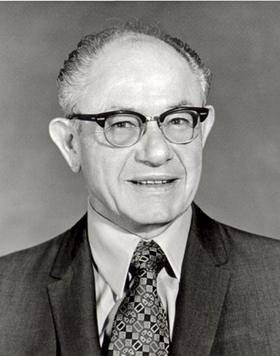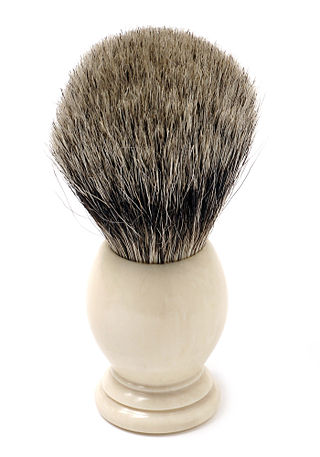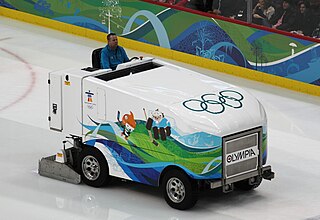
Ice skating is the self-propulsion and gliding of a person across an ice surface, using metal-bladed ice skates. People skate for various reasons, including recreation (fun), exercise, competitive sports, and commuting. Ice skating may be performed on naturally frozen bodies of water, such as ponds, lakes, canals, and rivers, and on human-made ice surfaces both indoors and outdoors.

Ice skates are metal blades attached underfoot and used to propel the bearer across a sheet of ice while ice skating.

Shaving is the removal of hair, by using a razor or any other kind of bladed implement, to slice it down—to the level of the skin or otherwise. Shaving is most commonly practiced by men to remove their facial hair and by women to remove their leg and underarm hair. A man is called clean-shaven if he has had his beard entirely removed.

A bulldozer or dozer is a large, motorized machine equipped with a metal blade to the front for pushing material: soil, sand, snow, rubble, or rock during construction work. It travels most commonly on continuous tracks, though specialized models riding on large off-road tires are also produced. Its most popular accessory is a ripper, a large hook-like device mounted singly or in multiples in the rear to loosen dense materials.

A razor is a bladed tool primarily used in the removal of body hair through the act of shaving. Kinds of razors include straight razors, safety razors, disposable razors, and electric razors.

Frank Joseph Zamboni Jr. was an American businessman and inventor whose most famous invention is the modern ice resurfacer, with his surname being registered as a trademark for these devices.

A squeegee or squilgee is a tool with a flat, smooth rubber blade, used to remove or control the flow of liquid on a flat surface. It is used for cleaning and in printing.

An ice rink is a frozen body of water and/or an artificial sheet of ice where people can ice skate or play winter sports. Ice rinks are also used for exhibitions, contests and ice shows. The growth and increasing popularity of ice skating during the 1800s marked a rise in the deliberate construction of ice rinks in numerous areas of the world.

A car wash, or auto wash, is a facility used to clean the exterior, and in some cases the interior, of cars. Car washes can be self-service, full-service, or fully automated. Car washes may also be events where people pay to have their cars washed by volunteers, often using less specialized equipment, as a fundraiser.

A straight razor is a razor with a blade that can fold into its handle. They are also called open razors and cut-throat razors. The predecessors of the modern straight razors include bronze razors, with cutting edges and fixed handles, produced by craftsmen from Ancient Egypt during the New Kingdom. Solid gold and copper razors were also found in Ancient Egyptian tombs dating back to the 4th millennium BC.
Frank J. Zamboni & Company is an American manufacturer of ice resurfacing equipment based in Paramount, California. Frank J. Zamboni developed the first ice resurfacing machine in 1949, and started the Zamboni Company in 1950. Zamboni is an internationally registered trademark.

A shaving brush or shave brush is a small brush with a handle parallel to the bristles used to make lather from shaving soap or shaving cream and apply it to the face when shaving. Shave brushes are often decorative; antique handles are often made from materials such as ivory or even gold, though the bristle load may be composed of any number of natural or synthetic materials. The shave brush is used most often today by "wet shavers" in tandem with a single- or double-edged safety razor or a straight razor. However, this is not always the case, as shavers of all varieties may employ the tool.
Tim Horton's Iceplex is a 180,000-square-foot (17,000 m2) non-profit indoor athletics facility in the Rochester, New York suburb of Brighton. Located on the campus of Monroe Community College, the arena was built in 1998. It is home to four regulation-size ice rinks for semi-professional, high school, and youth hockey teams' use. The Iceplex is home to youth hockey teams from Rochester Youth Hockey, Rochester Edge Girls Hockey, Rochester Coalition, Rochester Grizzlies Hockey, Perinton Youth Hockey, Spencerport High School Hockey, Roc City Roller Derby, Girls Selects Academy at Bishop Kearney, St. John Fisher Club Hockey, Nazareth Golden Flyers Men's and Women's Division III NCAA Hockey, Rochester Ice Cats Special Hockey, and other local teams. The arena also serves as the Rochester Americans official practice facility, and the USA Paralympic Sled Hockey Team chose it as their official training site in 2010.

An ice scraper is a handheld tool for removing frost, ice, and snow from windows, usually on automobiles. Basic scrapers have a plastic blade and handle, though some have blades made out of metal. More complex models often include brushes to help remove collected snow, or squeegees to remove water if the ambient temperature is near the melting point. Alternatively, the handle can be inside a glove-like enclosure to help keep the user's hands warm and dry when using the scraper.

A winter service vehicle (WSV), or snow removal vehicle, is a vehicle specially designed or adapted to clear thoroughfares of ice and snow. Winter service vehicles are usually based on a dump truck chassis, with adaptations allowing them to carry specially designed snow removal equipment. Many authorities also use smaller vehicles on sidewalks, footpaths, and cycleways. Road maintenance agencies and contractors in temperate or polar areas often own several winter service vehicles, using them to keep the roads clear of snow and ice and safe for driving during winter. Airports use winter service vehicles to keep both aircraft surfaces, and runways and taxiways free of snow and ice, which, besides endangering aircraft takeoff and landing, can interfere with the aerodynamics of the craft.

Shave ice or Hawaiian shave ice is an ice-based dessert made by shaving a block of ice and flavoring it with syrup and other sweet ingredients. On Hawai‘i Island, it is also referred to as "ice shave." In contrast, a snow cone, a similar American dessert, is made with crushed ice rather than shaved ice. The thin ice shavings of shave ice allow for the flavored syrups to be absorbed completely instead of sinking to the bottom. Hawaiian shave ice is derived from a similar ice-based dessert from Japan called kakigōri and thus involves similar production methods.

Tshuah-ping or Tsua bing, also known as Baobing in Mandarin, is a shaved ice dessert introduced to Taiwan under Japanese rule, and then spread from Taiwan to Greater China and countries with large regional Overseas Chinese populations such as Malaysia and Singapore. It is especially popular in Taiwan where the dish has a variation called xuehua bing (雪花冰), in which the ice is not made out of water but milk.

Resurfice Corporation is a manufacturer of ice resurfacing equipment based in Elmira, Ontario, Canada. Their Olympia brand product line includes push models through full size models built on a Chevy Powertrain. In early 2009, Don Schlupp, the company's director of sales and marketing, said that the company had about a 70% share of the market in North America, but later that year the company said it produces about the same number of machines as Zamboni.

The New England Sports Center is a two-story, eight-rink ice-skating facility located in Marlborough, Massachusetts. Covering 22.3 acres (90,000 m2) of suburban land, the 220,000-square-foot (20,000 m2) building has over 65 locker rooms, a hockey pro shop, ice skate sharpening, ice skate rentals, function rooms, a full-service restaurant, and a snack bar. In addition to the eight full-size rinks, the facility has two miniature ice surfaces, Rinks 9 and 10. Host to the Haydenettes, home to the Skating Club of Boston Metrowest, the Minuteman Flames, Central Mass. Outlaws, and the Junior Bruins hockey teams, the New England Sports Center is noteworthy for having more ice-skating surfaces than any other arena in the New England area.

Maggie Daley Park Ice Skating Ribbon is a seasonal public ice skating surface in the Maggie Daley Park section of Grant Park in the Loop community area of Chicago, which is bounded by Columbus Drive, Randolph Street, Monroe Street and Lake Shore Drive. The ice skating ribbon opened on December 13, 2014, along with the park. The rink extends for one-quarter mile (0.40 km) mile and has a capacity of 700 skaters. In the summer, the rink serves as a walking and rollerskating path. The rink features changes in elevation, which give it an incline and decline.




















